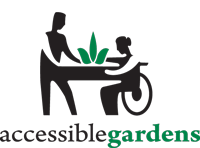One of the many rewards for living through a winter in the Northeast is, spring. Almost overnight it seems buds appear on the trees and daffodils and crocuses poke through the earth. My heart cheers as they tenaciously push through a late snow and I am itching to get out and get my hands in the dirt, my face in the sun and my heart communing with nature. Gardening provides not only food for my table but a tranquil and colorful setting to enjoy the outdoor weather.
There are numerous articles on the emotional as well as the physical benefits of gardening. A wise person once said; “to nurture a garden is to feed not just the body, but also the soul.” Gardening has proven therapeutic for people with depression and even Alzheimer’s dementia. However, anyone who has a garden will tell you that although their psyche might feel uplifted after a day tilling the soil, their body aches.
I am considered “able-bodied” and have noticed with each passing year it becomes more difficult to spend as much concentrated time digging, stooping, kneeling and hauling. I wondered if something existed to help people with physical disabilities enjoy working the soil and grow a garden. Perhaps, I too would benefit from incorporating more accessibility functionality into my gardening. It would certainly help me to continue doing what I love well into my later years, especially if I develop age-related physical impairments. This led me on a quest to see what’s available.
Sometimes the simplest ideas yield the most remarkable solutions. Just ask Raymond LaRoque, a gardening enthusiast who refused to let a cane and, eventually, a wheelchair deprive him of his passion for gardening. After a spinal cord injury took him out of a career in sales, a friend who knew of his interest in gardening built him a box on stilts and filled it with dirt. With a garden on stilts, the soil was at a level he could reach and work with. He was able to grow an assortment of vegetables like peas, beans, eggplant, basil, and tomatoes to name a few. His excitement grew along with his garden. When he did some research, he found there was nothing suitable in the market that allowed gardening in the manner he had adopted. As a result of his ingenuity, Accessible Gardens™ was born.
Contrary to the traditional garden built at ground level, or the typical raised garden bed contained within a walled perimeter built on ground level, the sturdy Accessible Gardens™ raised garden bed is elevated to table height, with ample clearance for wheelchairs or walkers. It puts the entire garden within arm’s reach with no kneeling or bending required. The garden area is large enough to grow an assortment of vegetables, herbs and a variety of edible and decorative flowers. Beyond that practical aspect of having a garden at table height LaRoque says, “Our Mission…is to enable every individual with a physical disability or limitation to enjoy the mental, physical, social and spiritual benefits of gardening.”
Susan M. Murray is on the Editorial Board of “Disability Issues”, a retired health care consultant and a Certified Master Gardener.
Disability Issues
Spaulding Hospital Cambridge
Cambridge, Massachusetts
by Susan Murray

